

Music. This article is about music as a form of art.
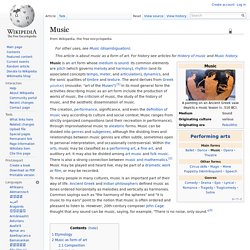
For history see articles for History of music and Music history. The creation, performance, significance, and even the definition of music vary according to culture and social context. Music ranges from strictly organized compositions (and their recreation in performance), through improvisational music to aleatoric forms. Music can be divided into genres and subgenres, although the dividing lines and relationships between music genres are often subtle, sometimes open to personal interpretation, and occasionally controversial. Within the arts, music may be classified as a performing art, a fine art, and auditory art.
To many people in many cultures, music is an important part of their way of life. Etymology The word derives from Greek μουσική (mousike; "art of the Muses").[4] Harmony. Barbershop quartets, such as this US Navy group, sing 4-part pieces, made up of a melody line (normally the lead) and 3 harmony parts.
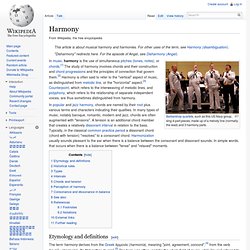
Etymology and definitions[edit] The term harmony derives from the Greek ἁρμονία (harmonía), meaning "joint, agreement, concord",[4] from the verb ἁρμόζω (harmozo), "to fit together, to join".[5] The term was often used for the whole field of music, while "music" referred to the arts in general. In Ancient Greece, the term defined the combination of contrasted elements: a higher and lower note.[6] Nevertheless, it is unclear whether the simultaneous sounding of notes was part of ancient Greek musical practice; "harmonía" may have merely provided a system of classification of the relationships between different pitches. Musical instrument. A musical instrument is a device created or adapted to make musical sounds.
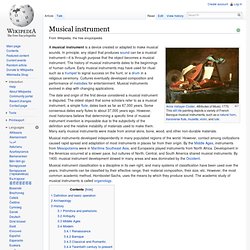
In principle, any object that produces sound can be a musical instrument—it is through purpose that the object becomes a musical instrument. The history of musical instruments dates to the beginnings of human culture. Early musical instruments may have used for ritual: such as a trumpet to signal success on the hunt, or a drum in a religious ceremony. Cultures eventually developed composition and performance of melodies for entertainment. Musical instrument classification. At various times, and in various cultures, various schemes of musical instrument classification have been used.

The most commonly used system in use in the west today divides instruments into string instruments, woodwind instruments, brass instruments and percussion instruments. However other ones have been devised, and some cultures also use different schemes. The 8-fold system of pa yin ("8 sounds"), from the same source, occurred gradually, and in the legendary Emperor Shun's time (3rd millennium BC) it is believed to have been presented in the following order: metal (chin), stone (shih), silk (ssu), bamboo (chu), gourd (p'ao), clay (t'u), leather (ko), and wood (mu) classes, and it correlated to the 8 seasons and 8 winds of Chinese culture, autumn and west, autumn-winter and NW, summer and south, spring and east, winter-spring and NE, summer-autumn and SW, winter and north, and spring-summer and SE, respectively (Kartomi, 1990). String instrument. Various stringed instruments of Chinese make on display in a shop.
String instruments are musical instruments that produce sound from vibrating strings. In most strings instruments, the vibrations are transmitted to the body of the instrument, which also vibrates, along with the air inside it. Guitar. History Before the development of the electric guitar and the use of synthetic materials, a guitar was defined as being an instrument having "a long, fretted neck, flat wooden soundboard, ribs, and a flat back, most often with incurved sides".[1] The term is used to refer to a number of chordophones that were developed and used across Europe, beginning in the 12th century and, later, in the Americas.[2] A 3,300-year-old stone carving of a Hittite bard playing a stringed instrument is the oldest iconographic representation of a chordophone.[3] The term guitar is descended from the Latin word cithara but the modern guitar itself is generally not believed to have descended from the Roman instrument.
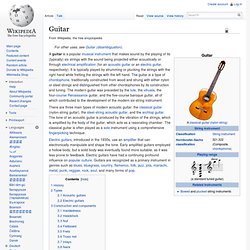
Many influences are cited as antecedents to the modern guitar. 3 Ways to Play Guitar. Steps Part 1 Learning the Basics <img alt="Image titled Play Guitar Step 1" src=" width="728" height="409" class="whcdn" onload="WH.performance.clearMarks('image1_rendered'); WH.performance.mark('image1_rendered');"> Guitar Step 1 Version 12.360p.mp4 00:00 00:26 00:26 spaceplay / pauseescstopffullscreenshift + ←→slower / faster (latest Chrome and Safari)←→seek . seek to previous 12…6 seek to 10%, 20%, …60% to Play Guitar1Identify the parts of the guitar.
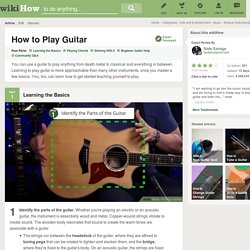
Whether you're playing an electric or an acoustic guitar, the instrument is essentially wood and metal. Copper-wound strings vibrate to create sound. Electric guitar. Invented in 1931, the electric guitar became a necessity as jazz musicians sought to amplify their sound in the big band format.
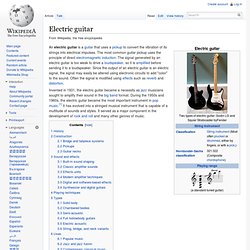
During the 1950s and 1960s, the electric guitar became the most important instrument in pop music.[1] It has evolved into a stringed musical instrument that is capable of a multitude of sounds and styles. It served as a major component in the development of rock and roll and many other genres of music. History[edit] The "Frying Pan", 1932 The need for the amplified guitar became apparent during the big band era as orchestras increased in size, particularly when guitars had to compete with large brass sections. Gibson Les Paul Custom 1954 The first solid body "Spanish" standard guitar was offered by Vivi-Tone no later than 1934. Wind instrument.
Methods for obtaining different notes[edit] Almost all wind instruments use the last method, often in combination with one of the others, to extend their register.

Types of wind instruments[edit] Wind instruments are typically grouped into two families: [1] Although brass instruments were originally made of brass and woodwind instruments have traditionally been made of wood, the material used to make the body of the instrument is not always a reliable guide to its family type. A more accurate way to determine whether an instrument is brass or woodwind is to examine how the player produces sound.
Harmonica. Reeds are pre-tuned to individual pitches.
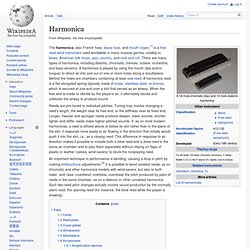
Tuning may involve changing a reed's length, the weight near its free end, or the stiffness near its fixed end. Longer, heavier and springier reeds produce deeper, lower sounds; shorter, lighter and stiffer reeds make higher-pitched sounds. If, as on most modern harmonicas, a reed is affixed above or below its slot rather than in the plane of the slot, it responds more easily to air flowing in the direction that initially would push it into the slot, i.e., as a closing reed.
This difference in response to air direction makes it possible to include both a blow reed and a draw reed in the same air chamber and to play them separately without relying on flaps of plastic or leather (valves, wind-savers) to block the nonplaying reed. Parts[edit] Comb and two reedplates. Reed plate. Reedplate mounted on the comb of a diatonic harmonica.
Richter-tuned harmonica. Blues Harp The Richter-tuned harmonica, or 10-hole harmonica (in Asia) or blues harp (in America), is the most widely known type of harmonica.
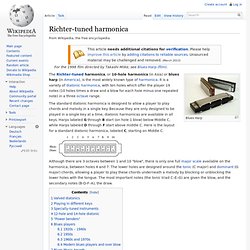
It is a variety of diatonic harmonica, with ten holes which offer the player 19 notes (10 holes times a draw and a blow for each hole minus one repeated note) in a three octave range. The standard diatonic harmonica is designed to allow a player to play chords and melody in a single key. Because they are only designed to be played in a single key at a time, diatonic harmonicas are available in all keys. How to Play a Harmonica: 7 steps. Steps Method 1 Getting Started <img alt="Image titled Play a Harmonica Step 1 preview" src=" width="728" height="410" class="whcdn" onload="WH.performance.clearMarks('image1_rendered'); WH.performance.mark('image1_rendered');">/images/thumb/c/c9/Play-a-Harmonica-Step-1-preview-Version-2.jpg/550px-Play-a-Harmonica-Step-1-preview-Version-2.jpg/images/thumb/c/c9/Play-a-Harmonica-Step-1-preview-Version-2.jpg/300px-Play-a-Harmonica-Step-1-preview-Version-2.jpg/9/92/Play a Harmonica Step 1 Version 2.360p.mp4 00:00 00:00 spaceplay / pauseescstopffullscreenshift + ←→slower / faster (latest Chrome and Safari)←→seek . seek to previous 12…6 seek to 10%, 20%, …60% 1Choose a harmonica.
List of musical instruments. The following is a list of musical instruments, categorized by section. This includes the variations of categories, but not the categories themselves. Example: There are eight types of flutes in the Western concert flute category, which are all metal. Therefore there are eight instruments listed in that category but the Western concert flute is not considered a musical instrument and is not listed in the count of instruments. Percussion instruments[edit] Idiophones[edit]